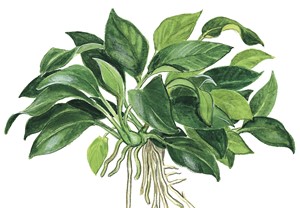Anubias: Hardy and Versatile Aquarium Plant for Every Aquascape
Anubias (family: Araceae) is an undemanding, easy plant and often one of the best suited plants for beginner aquascapes or tanks with unique conditions or specific aquatic life. Like other epiphytes, Anubias in your planted aquarium thrives tied to rock, wood or hardscape. It can also be planted in your soil substrate with it's rhizome exposed. It can be grown either submersed or emersed, and is even suitable for bare surface tanks. Anubias also makes an excellent choice for paludariums, growing partly emersed and partly submerged. Its natural growth habitat is commonly shady, fast-flowing water; firmly attached to large stones or tree trunks, emersed or semi-emersed, rarely submersed. Anubias adapts well with a variety of aquarium life, and can survive most highly active and aggressive fish species. It's hardy and leathery leaf surface, makes it suitable for adding plant life and color to cichlid tanks.
Anubias genus displays various shades of brilliant green leaves that are generally waxy in appearance, thick, stiff and hardy. The darker coloring of Anubias contrasts nicely with other aquascape plants. Its thick leaves are robust and can last several years. If older leaves perish, new leaves can sprout from the rhizome. When any leaves turn yellow, you can trim them to make room for new growth.
Anubias is a highly resistant genus; undemanding of light, CO2 or advanced nutrient additions, accepting of a wide range of water parameters. It has proven to easily adapt to all types of aquariums, making it an ideal plant for beginners or low maintenance aquascape concepts. It's very forgiving of less favorable growing conditions, and can actually help control algae in the tank, and may act as a shelter for your fish. It requires only essential maintenance, and can flourish in your aquarium in low-intensity light. Anubias prefers a tank with good water circulation. They are sensitive to algae, which is especially prevalent under higher lighting; these plants prefer low to moderate lighting. They can survive without CO2 supplementation, although they do flourish faster and larger when it is added. Under intense lighting and with CO2 addition, it grows faster and forms larger leaves, but is more prone to algae. A strong current is an advantage, and when combine with higher phosphate addition, it can help counteract the algae growth, and promote the formation of flowers.
Beautifully decorate the aquascape of your planted aquarium or naturally fill your spaces between roots or rocks. Anubias rhizomes thrive attached to a rock, driftwood, or tank decoration, and they can be float or be planted in soil. Use thread or fishing line to secure the rhizome and encourage it to root in a specific spot. Its rhizome will grow thick roots, attached to hardscape or soil, and will slowly develop new leaves. You can always plant the roots, but you cannot plant the rhizome because it will decay and cause the plant to die. This plant's food reserve is stored in the rhizome.
Anubias makes a lovely focal point in the middle or background of larger aquariums, and some varieties grow very large and tall. Nano Anubias varieties make excellent foreground plants. It is best to plan your aquascape with the anubias placed in a shaded area or under low light to prevent the growth of algae. Anubias grow very slowly, and is therefore quite sensitive to algae. It looks particularly lovely against plants with a soft texture, like mosses and delicate stem plants.
As with all Anubias, propagation of this plant in the aquarium is done by dividing the rhizome and replanting. If the plant is healthy, it should create side shoots from its rhizome that you can separate and then plant in your tank. The rhizome can be tied down or allowed to float about. It will eventually grow into a second plant.
- Common Varieties: Anubias Barteri Butterfly, Anubias Barteri Coffeefolia, Anubias Barteri Petite, Anubias Barteri Var Nana, Anubias Barteri Wrinkle Leave, Anubias Congensis Mini, Anubias Minima, Anubias Nana Bonsai, Anubias Nana Golden, Anubias Nana Petite, Anubias Nana Pinto, Anubias Nana Wrinkle Leave, Anubias Petite White
- Family: Araceae
- Type: Epiphyte
- Origin: West Africa (or Cultivar)
- Care: Easy, Low Maintenance
- Light: Low to medium, Intense lighting may cause algae
- CO2: Not required but will promote faster growth
- Propagation: Rhizome splitting and replanting
- Growth rate: Slow
- Fertilizer: not required, Phosphate help with algae growth and flowering
- Coloration: shades of dark green or light golden green (varies per variety)
- Growth State: emersed or submerged


Recent Posts
-
Bucephalandra: Coveted and Captivating Petite Epiphytes for Nature Aquarium
Bucephalandra aquarium plants, also commonly referred to as Buce plants, originate from the
-
Anubias: Hardy and Versatile Aquarium Plant for Every Aquascape
Anubias (family: Araceae) is an undemanding, easy plant and often one of the best suited plants for
